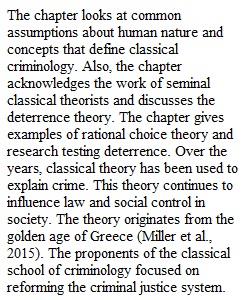


Q 1 Write a summary (key points) of Chapter 2 of the main textbook (Miller et al.'s Criminological Theory, 4th ed.), in a multi-level bullet-point format (write it in Word, save the file, and then attach the file to this assignment). If you are not sure what a multi-level bullet-point summary looks, google it! :) As an exception, I am giving you access to the first four chapters of the textbook if your textbook was ordered but has not arrived yet: https://www.dropbox.com/s/wdse7nxh10gioby/Miller_et_al_Crim_Theory_4th-ed_Ch_1-4.pdf?dl=0 (Links to an external site.) Due on the second to last day of Module 1.
View Related Questions